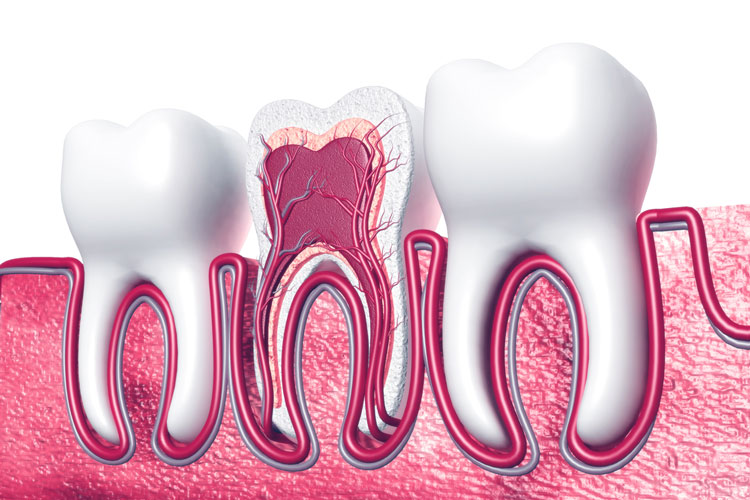
It turns out that a lot of people have just heard stories or mentions of root canals, but don’t actually even know what the procedure entails. Some people associate going to the dentist as something scary, but it doesn’t have to be. The best way to face any ‘dentist fears’ you may have, is to just know exactly what to expect. Understanding what you are dealing with, and what you are going to encounter, it will help a bit of any existing fear to diminish.
Out of the dental procedures that we have to go in for, for some reason, a stigma has formed most around that of the ‘dreaded root canal.’ But the truth is, the root canal is actually the hero in the story, not the villain. Root canals are there, to, in the end, relieve you of any pain. With modern-day technology and techniques, many patients report that they are perfectly comfortable during the procedure. Let’s go a little more in-depth to discover what a root canal truly entails…
“Why Do I Need a Root Canal?”
First off, let’s address why you may need a root canal. It’s important that this is stressed because it’s extremely important that you don’t put this sort of procedure off, as it will end up saving your tooth or teeth. The reason the root canal procedure is executed is because of the severe infection of a tooth (or teeth). The tissue inside the deep root of the tooth gets infected, which can cause severe pain, sensitivity, abscesses, and if not treated, even tooth loss. The procedure’s goal is to clean out any infection and bacteria within the root of the tooth, to get it back to a healthy and pain-free existence. Typically, the infection of the pulp within the tooth becomes infected because of an untreated cavity or an injury to the tooth (such as a chip).
What to Expect?
Treatment is usually performed over the span of two office visits. Let’s take a look at the four-step process of a root canal:
Step 1: A dentist will first numb the tooth by injecting it with local anesthesia. There will be a slight sting at first, but it will be very temporary. Once the tooth is numb, the endodontist will then place a small instrument in the mouth in order to keep the tooth isolated throughout the procedure.
Step 2: The dentist will need to then access the inside of the tooth, so by using various tools, such as a small drill, he or she will create a small opening in the top part of the tooth. Then he or she will clear away the damaged and infected pulp from the inside of the tooth with a small file. After clearing out the infected part of the tooth, your dentist may then apply some sort of antimicrobial solution in order to kill any bacteria remaining in the tooth and prevent further infections.
Step 3: After the tooth is cleaned out, the dentist will dry and fill it. The opening to the tooth will be closed with a temporary filling before the permanent crown is fitted.
Step 4: Finally, when you come for your next visit a few weeks later, your dentist will then complete the treatment by applying the permanent crown or similar restoration piece to the top of the tooth. The post-care of the procedure will then be given to you in detail by your dentist. You may require a follow-up visit, and perhaps an X-ray, to ensure that the tooth is remaining in proper health and that there are no returning infections.
Overall, there is no need to fear this procedure. With a good dentist and modern technology, any pain of the procedure will be minimal compared to the value of the treatment received leaving you with a healthy tooth. If you are looking for a family dentist in Las Colinas, or in need of root canal therapy in Irving, here at C&F Dentistry, we would be happy to have you. Let our caring team of experts help you get your teeth back to healthy and happy. Don’t hesitate to contact us today, and keep on smiling.
- Awareness16
- Bad Breath1
- Bone Grafting1
- Braces4
- Causes, Symptoms, And Treatments6
- Cavities5
- Chewing Gum1
- Cosmetic Dentistry of Las Colinas15
- COVID-192
- Deep Cleaning7
- Dental Anxiety1
- Dental Bridge2
- Dental Care27
- Dental Cleaning6
- Dental Crown1
- Dental Filling1
- Dental Health24
- Dental Implants6
- Dental Sedation1
- Dental Visit1
- Dental X Ray3
- Floss1
- Gum Dieseases4
- Injury1
- Insurance1
- Invisalign8
- Oral Cancer1
- Oral Hygiene24
- Root Canal9
- Sleep Apnea2
- Tartar1
- Teeth19
- Thanksgiving1
- TMJ1
- Tongue1
- Veneers2
- White Teeth12
Get Your Best Smile With Us
